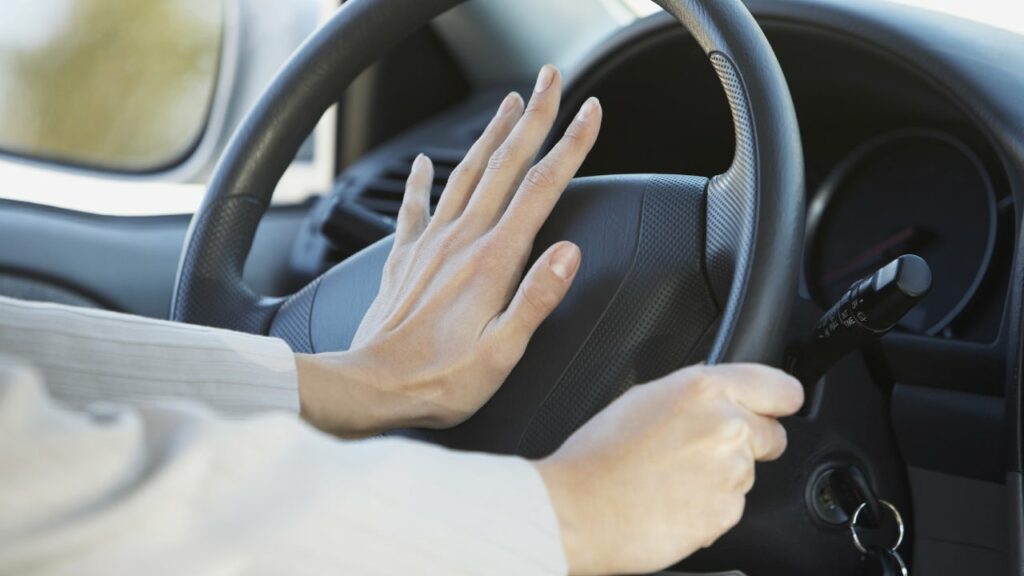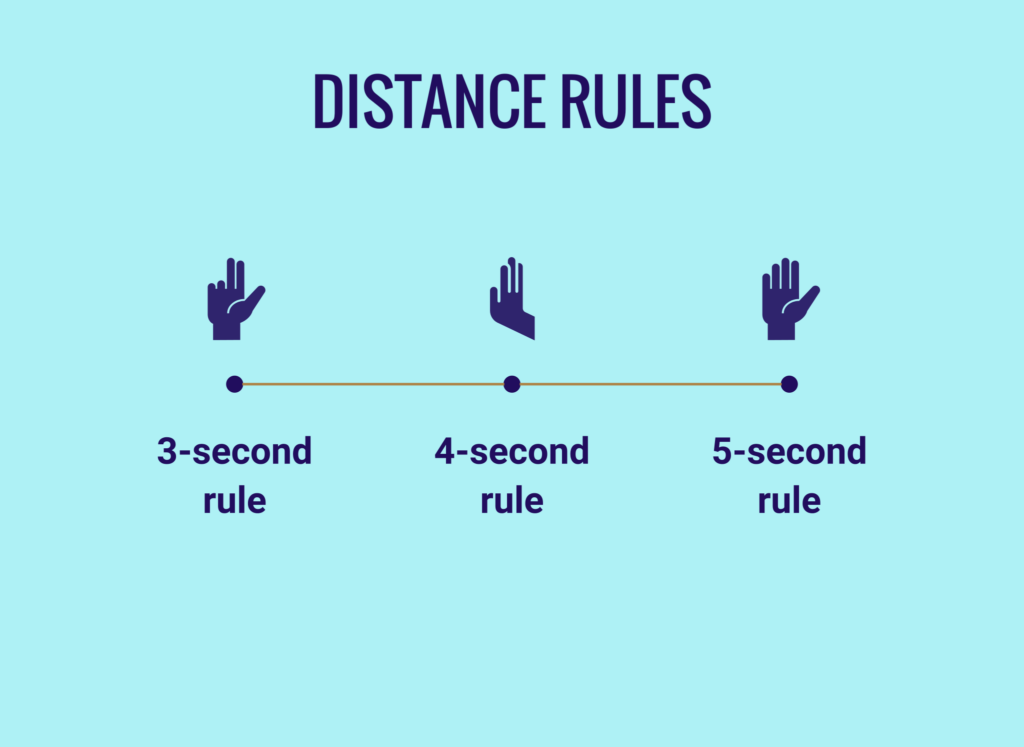Have you ever been late because of a slow-moving vehicle in front of you, desperately wanting to pass the distance between but unable to? Have you ever cut off another driver, risking your safety and theirs? You may have even shouted at someone from your car window.
If this sounds like something that happens to you regularly, then we have good news! There’s a way for all of us to get home safely without having road rage issues or creating more traffic congestion. It all starts with maintaining the proper distance between vehicles.
In this article, we will discuss the safe distance to drive from the car in front of you and the facts that can affect said distance. But first, let’s talk about the leading cause why this distance is often violated and disregarded by most drivers: road rage.
What is Road Rage?

Road rage is very aggressive behavior that may cause accidents and lead to many dangerous outcomes. It is often defined as an anger-driven, dangerous and violent behavior exhibited by drivers when they are driving on the road. When a driver gets angry while driving, it may lead to road rage, which in turn causes accidents or injuries.
Road rage can also happen due to other factors. Such reasons are the inability of the driver to drive correctly or the honking of horns by other drivers. But, these are all related in some way to anger and frustration that one’s self cannot control. The main reason for this is that if a person does not have patience, then they will get irritated easily even if there is no reason at all for irritation. This will, then, ultimately lead to committing mistakes like rash driving, tailgating, and swerving between lanes without caring about others who might be present ahead of them in those lanes too!
What Are The Major Causes Of Road Rage?
There are many causes of road rage, as we all know. Some drivers, for example, might get upset if you were to flash your headlights at them, but what about honking the horn? Or throwing objects at other vehicles? How far does one have to be from the car in front of them before they’re safe enough? To give you more specific causes of road rage, keep reading this section.
Poor driving habits
There are many possible triggers of road rage, but one of the most common is poor driving habits. These may include speeding, tailgating, and lane changing without signaling. It would help if you also avoided texting while driving and drinking alcohol while you’re behind the wheel.
It’s essential to be attentive and increase your awareness of your surroundings when you’re driving; otherwise, this can lead to accidents and frustrations on other drivers’ part. If someone else makes a mistake while they’re on the road with you, try not to let it cause an argument or trigger feelings of anger towards them. Instead, focus on being careful yourself so that no accidents happen!
Driving stress
Driving stress is a very common cause of road rage. And road rage is caused by poor driving habits and can be reduced by improving your driving skills, practicing mindful driving, and learning how to de-stress while on the road. That is why it is essential to calm your mind and fix anything that’s bothering you before driving.
Not having enough experience.
If it’s your first time driving in a city, then you are at risk of experiencing road rage. You may think that the drivers on the highway are dangerous. But, if you take a closer look at the roadways in your area, you’ll find that it’s actually the smaller streets that are more hazardous!
The reason for this is simple. Those who drive on highways know what they’re doing, and they have experience with high speeds, while those who drive on residential roads often lack such experience. Of course, there are exceptions. Some drivers who spend most of their time on highways become so accustomed to high speeds that their reaction is panic and confusion when they’re forced to travel through downtown areas at slower speeds (or even stop completely). This causes the drivers to lose control of their vehicles and ultimately leads to accidents among them as well as others around them.
The best way for novice drivers like yourself to avoid becoming involved in an accident caused by inexperience is by getting some practice under your belt before tackling busy cities or heavy traffic conditions during rush hour times! The more familiar you are with situations like these beforehand will help ensure that nothing goes wrong when faced with them later down the road, literally!
Being young
Young drivers are more likely to be involved in road rage incidents and accidents. This is because the younger you are, the less experience you have behind the wheel. For this reason, you’re more likely to be on edge when driving and have less control over your emotions when things go wrong on the road. Drivers who have been driving for a long time often develop a sense of calmness and management that helps them deal with difficult situations like bad drivers or dangerous weather conditions (like snowstorms).
Younger drivers may also lack communication skills that could help prevent conflicts from escalating into full-blown rage attacks. If someone cuts them off on a busy highway or passes them at an unsafe speed limit, they might not know how best to deal with it, or even if there is anything they can do about it!
Driving under the influence
Alcohol is a sample of depressant, and it slows down your brain and body. If you drink while driving, your reactions will be slower, causing you to drive more carefully at first (or perhaps not so carefully). But as the alcohol wears off and your body’s chemical balance returns to normal, your reaction time will return to normal too. And if this happens while you’re still driving under the influence of alcohol, then that could be very dangerous.
Road rage is a serious issue and needs to be addressed.
Road rage can be deadly and has been known to lead to more accidents and even death. It’s essential for drivers to be aware of this problem so that we can prevent road rage from happening in the future.
Specific Distance Between Cars

According to a recent study, statistically speaking, there is no safe distance to drive from the car in front of you. The study examined drivers’ responses at the wheel, their aggression levels, and other factors and found that most drivers who are close to another vehicle tend to tailgate and even pass them on the left side.
The researchers also found that these aggressive driving behaviors were linked with sleep deprivation, which is one reason why it’s so important for drivers to get enough sleep before hitting the roadways. This is especially true when they’re driving long distances during rush hour or trying to avoid traffic jams or accidents ahead of them. In fact, tailgating is one of many dangerous driving habits (e.g., texting while driving) that can lead to a multi-car accident if not corrected immediately after starting your engine!
How to Calculate the 2-Second Rule?
You can use the 2-second rule to help you find out how much distance to leave between your own vehicle and the vehicle in front of you. To do this, count two seconds as you pass a signpost or tree on the side of the road.
If it takes more than two seconds before you see this same object in your rear-view mirror, then that means that there is not enough space between your car and the one in front of it.
To calculate how far away from other vehicles on American roads needs to be for safety purposes, multiply your speed by two (that’s right, two) and then add 15 feet. This gives us: (2 x 60 mph) + 15 = 132 feet/43 meters, leaving room for error while driving at late hours or during inclement weather conditions such as foggy misty rainstorms.
How to Maintain a 2-Second Rule While Driving?

You should make sure that you keep enough gap between you and other vehicles.
If you want to drive safely, then you should make sure that you keep enough gap between you and other vehicles.
If there is an object such as a lamp post or tree on the roadside, then make sure that it is in clear view and about two seconds away from your car. This will help ensure that your car does not get too close to the vehicle in front of it or another car around it.
To maintain the 2-second rule, you should select a stationary object on the roadside, such as a lamppost, sign, or tree.
To maintain the 2-second rule while driving, you should select a stationary object on the roadside, such as a lamppost, sign, or tree. Next, use a clock or watch to count the seconds and keep it in your line of vision at all times. This can be not easy at first, but it will become second nature for you after some practice.
When you see an object flash past your view, like the headlights, stop counting until another reference point has passed and then start again from one with the number ‘1’ added on to the end of it like “1-2-3; 4-5-6….etc., until 20 seconds have elapsed before returning home.
If the vehicle has passed, then you should begin counting seconds. The count must be done in actual seconds and not by speed.
Once the vehicle has passed, you should begin counting seconds. You must do the counting in actual seconds, not by speed. You can do this in any way that works for you:
- saying the numbers aloud
- counting silently in your mind
- depending on your fingers on one hand when counting (or both hands)
- counting with all five digits of one foot (or both feet)
It is critical to maintain at least two seconds distance from the vehicle in front. This will enhance safety and prevent accidents.
It is essential to maintain at least two seconds distance from the vehicle in front. This will enhance safety and prevent accidents.
Maintaining a safe distance will also save fuel, which is a vital aspect for all of us. The more we use fuel, the more money we spend on it, so it’s critical that we can keep this cost under control.
To ensure that you don’t get into an accident, maintain a safe distance while driving.
To ensure that you don’t get into an accident, you must always need to maintain a safe distance while driving. It would help if you always kept a safe distance from the vehicle in front of you. In addition to maintaining a safe distance, it is also essential to make sure that you keep enough gap between you and other vehicles on the road.
Are There Any Other Rules for Safe Distance on the Roads?

3-second rule
The 3-second rule is used in most driving schools. It would help if you tried to keep a distance of at least three seconds between cars ahead of you. This allows you to react impulsively to any sudden braking or turns of the car in front of you.
4-second rule
Some drivers use a 4-second rule, which means that they must be four seconds behind the vehicle in front at all times. While this may not be practical on busy roads and highways, it’s crucial if you are driving on small country roads where visibility is poor, and intersections could appear suddenly.
5-second rule
The 5-second rule is another common one that many people follow when driving in town or on rural roads. It states that drivers should keep about five seconds between their own vehicle and the one ahead of them at all times for safety reasons; however, this can vary depending on how fast or slow other cars are traveling as well as road conditions like heavy rain or foggy weather (which reduces visibility).
REDUCING THE RISK OF ACCIDENTS
Anger and rage aren’t something you can just throw out of the window while driving. Fortunately, there are some methods you do that can reduce and minimize the risk of losing your cool while driving. Below are some tips for preventing road rage even before you start your engine and even if you are already on the road:
Avoid sleep deprivation as much as possible.
Besides causing us to become less alert on the road, sleep deprivation can also cause us to become more irritable and prone to intense mood swings. You can be calm when you leave the house and face the sudden traffic with your face turning red. Even though certain obstructions in the road can easily cause anyone to become a steaming pile of rage, having sleep deprivation can also make things worse.
In terms of following the safe distance rule we mentioned, being sleep-deprived can suppress your ability to precisely take a glimpse at the distance. This is because your eyes tend to fall as if they are begging you to take a quick nap.
Take anger management programs or mental health assistance.
This isn’t to exaggerate a short temper, but underlying mental conditions can often lead to anger management problems. Who knows? Maybe seeing a professional or taking anger management programs can help you identify a particular mental state that you didn’t know you had.
Therapists, psychologists, and counselors can all help identify some unresolved problems that you may have disregarded in the past. All these factors can eventually solve or minimize your temper. It doesn’t hurt to take time for yourself, even if that means seeking help from others to do so progressively.
You can always pull over if the situation gets too rough.
Anger can accumulate in a way where it can’t be removed unless released or if you take away the stressful situation that amplifies it. If you are on the road, you definitely want to take away the stressor instead of releasing it to other people. Thus, if you feel the need to, pull over on the side of the road and take a breather. If you keep a bottle of water or have a tumbler with you, then rehydrate. You may also listen to music that soothes you or keeps you at peace. This can relieve road rage and allow you to drive precisely and with a clear mind.
Bottom Line
Distance isn’t always a bad thing (even in messy relationships!), and often it can be healthy if it is in the appropriate measurement. This mainly applies in driving, where precision, regulation, and discipline are necessary to keep you, your passengers, pedestrians, and other vehicles safe from accidents.
Besides distance, there needs to be composure and patience when it comes to driving. Both of these factors go hand in hand with one another, as humans tend to ignore the rules if intense emotions are involved. Just remember that whoever is the one who rages loses. It is not your loss if you keep calm during a situation that requires a clear and focused mind.
To know about the mortality rates of car accidents in the U.S, check the next article by clicking here.
